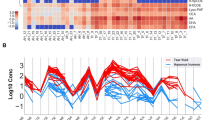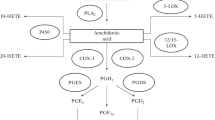Abstract
Background
This study was conducted to evaluate whether polyunsaturated fatty acids (PUFA) such as γ-linolenic acid (GLA) and eicosapentaenoic acid (EPA), as found in the diet, may affect the lipid composition of conjunctival epithelium and whether these modifications affect prostaglandin (PG) production after inflammatory stimulation.
Methods
Chang and IOBA-NHC conjunctival human cells were treated with GLA and/or EPA at 5, 10, 20, 30, 40, or 50 μg/ml for 72 h and then were stimulated with interferon-gamma (IFN-γ) for 48 h. Changes in the composition of neutral lipids and phospholipids were monitored by gas chromatography. PGE1 and PGE2 levels were measured by enzyme immunoassay.
Results
PUFA supplementations in the culture medium induced incorporation of these fatty acids and of their metabolites in neutral lipids and phospholipids of the conjunctival cells. The fatty acid composition of neutral lipids and phospholipids was not affected by stimulation with IFN-γ. The production of PGE1 and PGE2 was affected by GLA supplementation whereas it was not modified by EPA supplementation. A combined supplementation of EPA and GLA did not change the production of PGE1 but decreased the production of PGE2.
Conclusions
These results suggest that modulation of fatty acid composition and PG production by PUFA supplementation is possible in the conjunctival epithelium, which is an important site of inflammation in dry eye syndrome.





Similar content being viewed by others
Abbreviations
- AA:
-
Arachidonic acid
- ALA:
-
α-linolenic acid
- COX:
-
Cyclo-oxygenase
- dGLA:
-
Dihomo γ-linolenic acid
- DHA:
-
Docosahexaenoic acid
- EPA:
-
Eicosapentaenoic acid
- FAME:
-
Fatty acid methyl ester
- GLA:
-
γ-Linolenic acid
- IFN-γ:
-
Interferon-γ
- LA:
-
Linoleic acid
- NF-κB:
-
Nuclear factor κB
- PG:
-
Prostaglandin
- PPAR:
-
Peroxisome proliferator activated receptor
- PUFA:
-
Polyunsaturated fatty acid
References
Bourre JM (2006) Effects of nutrients (in food) on the structure and function of the nervous system: update on dietary requirements for brain. Part 2: macronutrients. J Nutr Health Aging 10:386–99
Schnebelen C, Pasquis B, Salinas-Navarro M, Joffre C, Creuzot-Garcher CP, Vidal-Sanz M, Bron AM, Bretillon L, Acar N (2009) A dietary combination of omega-3 and omega-6 polyunsaturated fatty acids is more efficient than single supplementations in the prevention of retinal damage induced by elevation of intraocular pressure in rats. Graefes Arch Clin Exp Ophthalmol
Schnebelen C, Viau S, Gregoire S, Joffre C, Creuzot-Garcher CP, Bron AM, Bretillon L, Acar N (2009) Nutrition for the eye: different susceptibility of the retina and the lacrimal gland to dietary omega-6 and omega-3 polyunsaturated fatty acid incorporation. Ophthalmic Res 41:216–24
Viau S, Maire MA, Pasquis B, Gregoire S, Acar N, Bron AM, Bretillon L, Creuzot-Garcher CP, Joffre C (2009) Efficacy of a 2-month dietary supplementation with polyunsaturated fatty acids in dry eye induced by scopolamine in a rat model. Graefes Arch Clin Exp Ophthalmol 247:1039–50
Barham JB, Edens MB, Fonteh AN, Johnson MM, Easter L, Chilton FH (2000) Addition of eicosapentaenoic acid to gamma-linolenic acid-supplemented diets prevents serum arachidonic acid accumulation in humans. J Nutr 130:1925–31
Miles EA, Banerjee T, Calder PC (2004) The influence of different combinations of gamma-linolenic, stearidonic and eicosapentaenoic acids on the fatty acid composition of blood lipids and mononuclear cells in human volunteers. Prostaglandins, Leukot Essent Fatty Acids 70:529–38
Calder PC (2006) n-3 polyunsaturated fatty acids, inflammation, and inflammatory diseases. Am J Clin Nutr 83:1505S–1519S
Culp BR, Titus BG, Lands WE (1979) Inhibition of prostaglandin biosynthesis by eicosapentaenoic acid. Prostaglandins Med 3:269–78
Schnebelen C, Gregoire S, Pasquis B, Joffre C, Creuzot-Garcher CP, Bron AM, Bretillon L, Acar N (2009) Dietary n-3 and n-6 PUFA enhance DHA incorporation in retinal phospholipids without affecting PGE(1) and PGE (2) levels. Lipids 44:465–70
Stern ME, Pflugfelder SC (2004) Inflammation in dry eye. Ocul Surf 2:124–30
Aragona P, Bucolo C, Spinella R, Giuffrida S, Ferreri G (2005) Systemic omega-6 essential fatty acid treatment and pge1 tear content in Sjögren's syndrome patients. Invest Ophthalmol Vis Sci 46:4474–9
Barabino S, Rolando M, Camicione P, Ravera G, Zanardi S, Giuffrida S, Calabria G (2003) Systemic linoleic and gamma-linolenic acid therapy in dry eye syndrome with an inflammatory component. Cornea 22:97–101
Creuzot-Garcher C (2006) Lacrimal film and the ocular surface. J Fr Ophtalmol 29:1053–9
Macri A, Giuffrida S, Amico V, Iester M, Traverso CE (2003) Effect of linoleic acid and gamma-linolenic acid on tear production, tear clearance and on the ocular surface after photorefractive keratectomy. Graefes Arch Clin Exp Ophthalmol 241:561–6
Wojtowicz JC, Butovich I, Uchiyama E, Aronowicz J, Agee S, McCulley JP (2011) Pilot, prospective, randomized, double-masked, placebo-controlled clinical trial of an omega-3 supplement for dry eye. Cornea 30:308–14
Miljanovic B, Trivedi KA, Dana MR, Gilbard JP, Buring JE, Schaumberg DA (2005) Relation between dietary n-3 and n-6 fatty acids and clinically diagnosed dry eye syndrome in women. Am J Clin Nutr 82:887–93
Leventhal LJ, Boyce EG, Zurier RB (1993) Treatment of rheumatoid arthritis with gammalinolenic acid. Ann Intern Med 119:867–73
Kulkarni PS, Srinivasan BD (1989) Cyclooxygenase and lipoxygenase pathways in anterior uvea and conjunctiva. Prog Clin Biol Res 312:39–52
Goustard-Langelier B, Alessandri JM, Raguenez G, Durand G, Courtois Y (2000) Phospholipid incorporation and metabolic conversion of n-3 polyunsaturated fatty acids in the Y79 retinoblastoma cell line. J Neurosci Res 60:678–85
Folch J, Lees M, Sloane-Stanley G (1957) A simple method for the isolation and purification of total lipids from animal tissues. J Biol Chem 226:497–509
Juaneda P, Rocquelin G (1985) Rapid and convenient separation of phospholipids and non-phosphorus lipids from rat heart using silica cartridges. Lipids 20:40–41
Joffre C, Souchier M, Gregoire S, Viau S, Bretillon L, Acar N, Bron AM, Creuzot-Garcher C (2008) Differences in meibomian fatty acid composition in patients with meibomian gland dysfunction and aqueous-deficient dry eye. Br J Ophthalmol 92:116–9
Wang Y, Botolin D, Xu J, Christian B, Mitchell E, Jayaprakasam B, Nair MG, Peters JM, Busik JV, Olson LK, Jump DB (2006) Regulation of hepatic fatty acid elongase and desaturase expression in diabetes and obesity. J Lipid Res 47:2028–41
Zheng X, Torstensen BE, Tocher DR, Dick JR, Henderson RJ, Bell JG (2005) Environmental and dietary influences on highly unsaturated fatty acid biosynthesis and expression of fatty acyl desaturase and elongase genes in liver of Atlantic salmon (Salmo salar). Biochim Biophys Acta 1734:13–24
Nakamura MT, Nara TY (2004) Structure, function, and dietary regulation of delta6, delta5, and delta9 desaturases. Annu Rev Nutr 24:345–76
Williard DE, Kaduce TL, Harmon SD, Spector AA (1998) Conversion of eicosapentaenoic acid to chain-shortened omega-3 fatty acid metabolites by peroxisomal oxidation. J Lipid Res 39:978–86
Sprecher H, Luthria DL, Mohammed BS, Baykousheva SP (1995) Reevaluation of the pathways for the biosynthesis of polyunsaturated fatty acids. J Lipid Res 36:2471–7
Obata T, Nagakura T, Masaki T, Maekawa K, Yamashita K (1999) Eicosapentaenoic acid inhibits prostaglandin D2 generation by inhibiting cyclo-oxygenase-2 in cultured human mast cells. Clin Exp Allergy 29:1129–35
Herman CA, Hamberg M, Granstrom E (1987) Quantitative determination of prostaglandins E1, E2 and E3 in frog tissue. J Chromatogr 394:353–62
Raisz LG, Alander CB, Simmons HA (1989) Effects of prostaglandin E3 and eicosapentaenoic acid on rat bone in organ culture. Prostaglandins 37:615–25
Rubin D, Laposata M (1991) Regulation of agonist-induced prostaglandin E1 versus prostaglandin E2 production. A mass analysis J Biol Chem 266:23618–23
He J, Bazan HE (2010) Omega-3 fatty acids in dry eye and corneal nerve regeneration after refractive surgery. Prostaglandins Leukot Essent Fatty Acids 82:319–25
Mukherjee PK, Chawla A, Loayza MS, Bazan NG (2007) Docosanoids are multifunctional regulators of neural cell integrity and fate: significance in aging and disease. Prostaglandins Leukot Essent Fatty Acids 77:233–8
Serhan CN, Chiang N (2008) Endogenous pro-resolving and anti-inflammatory lipid mediators: a new pharmacologic genus. Br J Pharmacol 153(Suppl 1):S200–15
Li N, He J, Schwartz CE, Gjorstrup P, Bazan HE (2010) Resolvin E1 improves tear production and decreases inflammation in a dry eye mouse model. J Ocul Pharmacol Ther 26:431–9
Christman JW, Lancaster LH, Blackwell TS (1998) Nuclear factor kappa B: a pivotal role in the systemic inflammatory response syndrome and new target for therapy. Intensive Care Med 24:1131–8
Zhao Y, Joshi-Barve S, Barve S, Chen LH (2004) Eicosapentaenoic acid prevents LPS-induced TNF-alpha expression by preventing NF-kappaB activation. J Am Coll Nutr 23:71–8
Tsubota K, Fukagawa K, Fujihara T, Shimmura S, Saito I, Saito K, Takeuchi T (1999) Regulation of human leukocyte antigen expression in human conjunctival epithelium. Invest Ophthalmol Vis Sci 40:28–34
Lavappa KS, Macy ML, Shannon JE (1976) Examination of ATCC stocks for HeLa marker chromosomes in human cell lines. Nature 259:211–3
Guenoun JM, Baudouin C, Rat P, Pauly A, Warnet JM, Brignole-Baudouin F (2005) In vitro comparison of cytoprotective and antioxidative effects of latanoprost, travoprost, and bimatoprost on conjunctiva-derived epithelial cells. Invest Ophthalmol Vis Sci 46:4594–9
Diebold Y, Calonge M, Enriquez de Salamanca A, Callejo S, Corrales RM, Saez V, Siemasko KF, Stern ME (2003) Characterization of a spontaneously immortalized cell line (IOBA-NHC) from normal human conjunctiva. Invest Ophthalmol Vis Sci 44:4263–74
Acknowledgements
This work was supported by The Nutrition, Chemical Food Safety and Consumer Behaviour Division from INRA (Dijon, France) for S. Viau (BTH01698). The authors would like to thank Yolanda Diebold in Valladolid (Spain) for providing the IOBA-NHC conjunctival human cells.
Author information
Authors and Affiliations
Corresponding author
Additional information
Financial support
The Nutrition Chemical Food Safety and Consumer Behaviour Division from INRA (Dijon, France) provided financial assistance to S. Viau (BTH01698).
Rights and permissions
About this article
Cite this article
Viau, S., Leclère, L., Buteau, B. et al. Polyunsaturated fatty acids induce modification in the lipid composition and the prostaglandin production of the conjunctival epithelium cells. Graefes Arch Clin Exp Ophthalmol 250, 211–222 (2012). https://doi.org/10.1007/s00417-011-1801-y
Received:
Revised:
Accepted:
Published:
Issue Date:
DOI: https://doi.org/10.1007/s00417-011-1801-y




